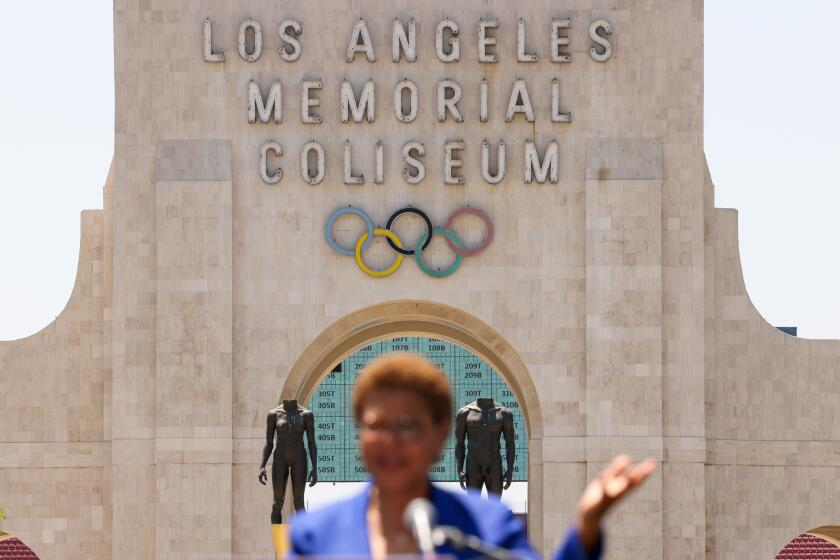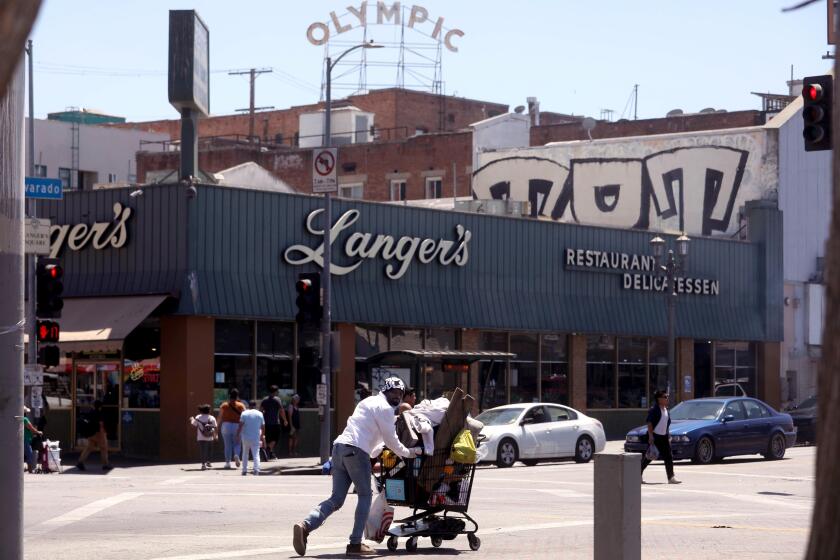Opinion: One group is responsible for America’s culture of violence, and it isn’t cops, black Americans, Muslims or rednecks. It’s men
On Thursday morning, a fire alarm in the Los Angeles Times’ building went off. Fortunately, the dozens of office alarms I’ve heard over the years have always been drills or misfiring systems. For the first time, instead of begrudgingly grabbing my belongings and traipsing downstairs, I was afraid. For the first time, the thought in my mind wasn’t “drill” but “shooter.”
Americans are united in our fear of violence and divided on which members of our society are most likely to perpetrate it. Some of these finger-pointing conversations are productive; they teach us how to address and reduce violence. Some are unproductive; they are rooted in ignorance and reinforce dangerous stereotypes.
In the wake of the Orlando, Fla., shooting, some conservative politicians called for the use of the term “radical Islam” to label the violent movement with which Omar Mateen identified himself. In the wake of the police shootings of Alton Sterling and Philando Castile, many called for a review of violence by law enforcement against black Americans. And after Dallas, some piled on the Black Lives Matter movement, suggesting that the gunman was spurred to murder because he’d made reference to the group. Others use the term “black-on-black violence” to refer to the killings of poor black Americans in their communities, playing into what author Ta-Nehisi Coates has labeled “the enduring myth of black criminality.”
What we don’t talk about is how the greatest predictor of violence isn’t religion, occupation or race. It’s gender.
In the United States, 98% of those who commit mass shootings are male; 98% of the officers who have shot and killed civilians are male; 90% of those who commit homicide by any means are male; and 80% of those arrested for all violent crimes — murder and non-negligent manslaughter, forcible rape, robbery and aggravated assault — are male.
When that fire alarm rang at the Times’ building, the image of “shooter” that flashed through my mind wasn’t identifiably white, black, Christian or Muslim. But there was no question in my mind that person was male.
If women are less likely to kill strangers, could increasing the number of women on the police force reduce officer-involved killings?
When you look at the numbers, one thing emerges over and over: Violent female offenders are unlikely to kill people they don’t know. Most mass shootings are committed against strangers, although there are notable exceptions, such as in San Bernardino. When women commit murder, their victim is a stranger only 7% of the time. When men commit murder, their victim is a stranger 25% of the time.
If women are less likely to kill strangers, could increasing the number of women on the police force reduce officer-involved killings? A 2002 study by the National Center for Women and Policing shows that, although women comprise 12.7% of sworn police personnel in urban centers, only 5% of citizen complaints for excessive force involve female police officers. The average male officer is two to three times more likely to be named in an excessive force complaint.
“That was nearly 15 years ago,” you may say. “Let’s see some newer data on the role of gender in policing.” I agree. You might also wonder whether male officers are far more likely than female ones to choose assignments in which drawing a weapon is a real possibility.
It’s a significantly under-studied area — which is why it’s so crucial to talk about the role men play in America’s epidemic of violence. We need serious, current research in order to understand why male police officers are more violent in their interactions with citizens and how the culture of policing can be changed.
There are myriad theories as to why men are nearly 50 times more likely to commit murder than women. Some neuroscientists say testosterone is directly connected to aggression and competition, attitudes that are correlated with violence. Some evolutionary psychologists say that more aggressive men have historically been able to procure more women, food and land. Some psychotherapists have argued that men are raised to suppress vulnerable emotions, which leads them to become overwhelmed and express pain physically rather than verbally. Some sociologists, meanwhile, have found a correlation between violent videogame play and increased aggression in the real world, while other studies find no strong link between these games and violent acts.
Regardless of whether there is a causal relationship, popular entertainment, such as video games and action movies, teaches men from an early age that violence is an expression of strength.
See the most-read stories this hour »
Ostensibly, the discrepancy could simply be that men are more likely to kill people than women because they are more able; a man may have the strength to beat or strangle a woman to death, whereas a woman may have the strength only to injure a man. But if physicality alone, rather than brain chemistry or socialization, were the reason that men kill at a much higher rate than women, then we would expect guns to be a leveling technology. The statistics, however, do not bear this out. From 1980 to 2014, the gender gap in gun ownership closed by 17%. Yet the rates at which men and women kill have remained relatively stable.
The reality is that we don’t know exactly why men are exponentially more prone to violence. If we are going to reduce mass shootings, officer-involved killings and the culture of violence in America, however, we need to talk about it.
Batchelor Warnke is an intern in The Times’ Opinion section. Follow her on Twitter @velvetmelvis.
Follow the Opinion section on Twitter @latimesopinion or Facebook.
MORE FROM OPINION
This year’s Republican National Convention will be super weird and super white
A father worries about a daughter in France
How is bombing the Mideast supposed to stop attacks like the one in Nice, France?
More to Read
A cure for the common opinion
Get thought-provoking perspectives with our weekly newsletter.
You may occasionally receive promotional content from the Los Angeles Times.







